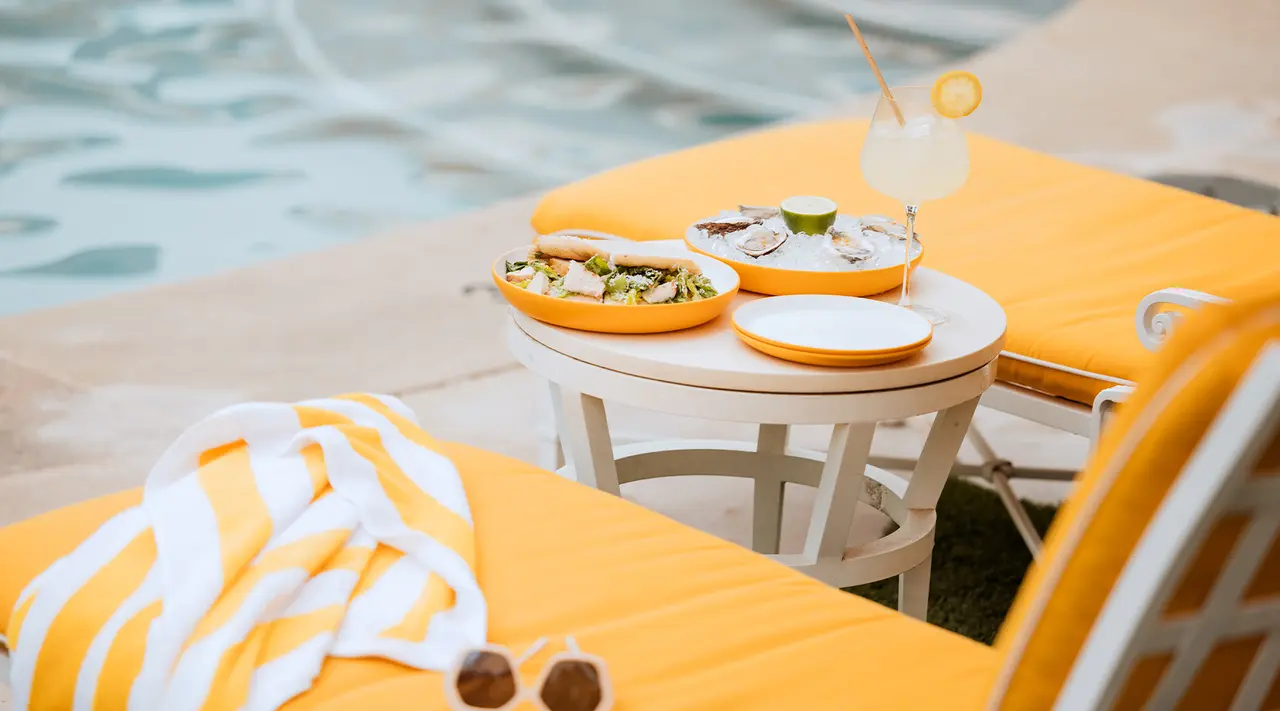You know those plates at your favorite local restaurant? The ones with the vibrant colors and chic prints that look like expensive porcelain, yet somehow feel as light as plastic? Those are melamine—aka, the lightweight, durable, dishwasher-safe alternative to ceramic dishes.
Melamine dinnerware is about as practical and durable as it is aesthetically pleasing—i.e., perfect for outdoor dining. Here’s everything you need to know about it to celebrate the launch of our brand-new Outdoor Dining Collection, designed in partnership with Austin’s iconic and luxurious Auberge property, the Commodore Perry Estate.
What Is Melamine Dinnerware?

Technically speaking, melamine is a nitrogen-rich organic compound used in everything from food packaging to laminate flooring, though it’s commonly used to refer to items where melamine is the main component (like dinnerware).
Melamine products are made by combining melamine (the compound) with other strengthening materials and heating them, forming a resin. This resin is used to produce a hard, scratch-resistant, shatterproof, lightweight material—aka, all the things we look for in an outdoor dining set.
Benefits of Melamine Dinnerware

We could go on and on about the benefits of melamine dinnerware—but for brevity’s sake, here are just a few of our favorites.
Durability
We’ll get into this more in the following sections, but one of the major selling points of melamine is the fact that it’s highly durable. Even if it looks like regular plastic, it’s much more resistant to breaking, chipping, scratching, shattering, and most other forms of damage—including heat. This is a must-have for most dinnerware, but especially dinnerware you’ll be using outdoors.
Easy to Clean and Maintain
We prefer our outdoor dinnerware (and all dinnerware, honestly) to be easy to clean. This is one of the other advantages of melamine—along with being dishwasher-friendly, melamine’s scratch-resistant finish means that it won’t harbor bacteria as easily as softer materials.
One care aspect of melamine dinnerware to note is that it is not microwave safe. If you need to reheat something, we recommend transferring to a microwave-safe plate.
Heat Resistance
Porcelain or stoneware dishes can get uncomfortably—even dangerously—hot when left in direct sunlight, something you don’t really want to worry about when you’re preparing an al fresco spread or eating pool- or oceanside.
Luckily, melamine is prized for its heat resistance, meaning it doesn’t absorb heat as much or as quickly as other dinnerware materials.
Lightweight Composition
Because of melamine’s plastic-like composition, it’s extremely lightweight. This makes it ideal for stacking, transporting to and from campsites, and carrying from the kitchen to the porch or patio.
Resistance to Breakage and Chipping
Despite its porcelain-like appearance, melamine is impressively resilient: you can knock it over, drop it, or bang it with cutlery, and it’s unlikely to chip, break, or even scratch. Of course, it’ll wear down more quickly with heavy use, so try not to do these things too often, if you can help it.
Melamine vs. Traditional Dinnerware

We love the idea of an outdoor dinner party with real ceramic or glass dishes—we really do. What we love less, however, is the thought of carrying stacks of heavy dishes back and forth between the patio and kitchen, sun-baked plates burning our fingers, and shattered salad bowls.
This is what makes melamine such a game-changer: it’s thicker and sturdier (read as: more durable) than most plastic plates, yet light enough to make it easy to transport and stack—a major asset when you’re serving food outdoors. It’s also, thankfully, made with BPA-free, non-toxic materials, and totally food- and dishwasher-safe.
Sustainability and Environmental Considerations

If you're trying to phase out disposable plates, melamine should be top of your list. While it’s not as easy to recycle through conventional recycling systems as other types of plastic, its durability and dishwasher-friendliness make it an eco-friendly swap for the single-use plastic and paper dinnerware that's so popular at outdoor gatherings.
Plus, unlike many of these single-use products, melamine is also free of BPA and PFAS, both of which can be extremely harmful to human and environmental health.
Ready to Shop?
Playful yet chic, elegant yet unfussy, melamine embodies so much of what we love about summer—and summer eating. If you haven’t already started building your melamine collection, now is the perfect time to start: our new Outdoor Dining Collection comes with everything you need to host your own laid-back, yet elegant outdoor gathering.
And in three luxurious colorways—one that that pays homage to Austin’s Commodore Perry Estate—you can capture the best parts of high-end summer dining without leaving your backyard.
























